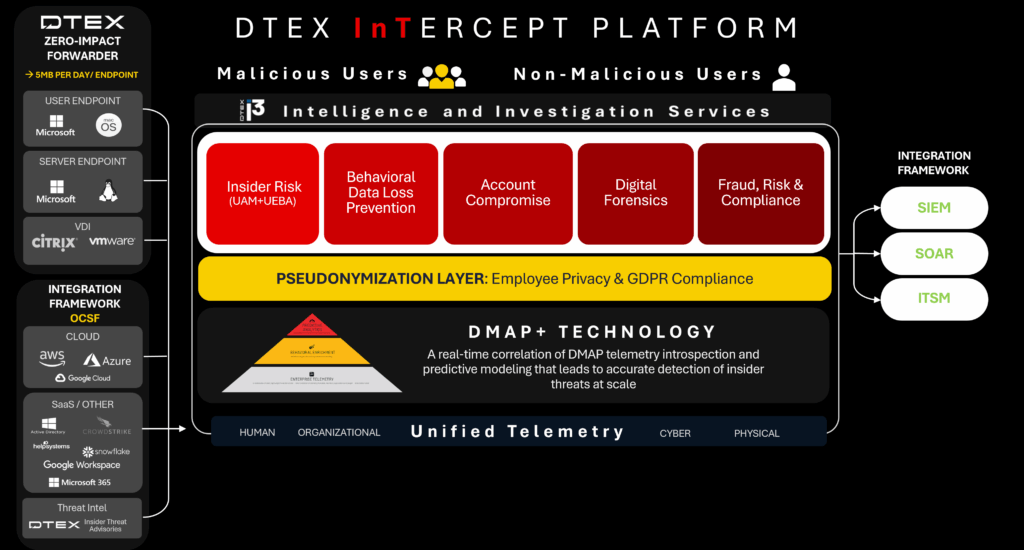DTEX insider risk management platform: agent, agentless — or something better?
One of the most common questions we hear is whether DTEX is agent-based or agentless.
The short answer? It’s a bit of both — but better, and ultimately something entirely different.
This blog breaks down how the DTEX insider risk management platform sidesteps common issues associated with agents (outlined below) by rethinking what data should be collected, how it should be processed, and how to build a scalable foundation for human-centric insider risk management.
Before we dive in, it’s important to clarify what we mean by “agent”—and why it is often met with resistance.
What is an agent? And why are organizations wary of adding another one?
An agent, in the context of cybersecurity, refers to a piece of software installed directly on an endpoint device—like a laptop, server, or workstation—to monitor activity, enforce policies, or collect data. While agents can offer deep visibility and control, they often come with trade-offs: compatibility issues, increased computational load, and potential performance degradation. Most organizations are already managing a complex array of such tools, which makes the addition of another agent a non-trivial decision. As a result, many security teams are increasingly cautious about agent-based solutions, carefully weighing the operational overhead against the security benefits.
What is “agentless”?
Agentless solutions use existing infrastructure to monitor activity without installing software on endpoints. They’re easier to deploy and scale but offer less real-time, granular visibility.
What makes DTEX unique?
DTEX offers a hybrid approach that delivers the best of both agent-based and agentless solutions, without inheriting their weaknesses. Think of it as a “lightweight forwarder” that provides the visibility of agent-based solutions without the traditional drawbacks (excessive load, processing demands, and compatibility issues to name a few).
This is especially relevant for organizations that have spent years investing in SIEMs, User and Entity Behavior Analytics (UEBA), Data Loss Prevention (DLP), and Endpoint Detection and Response (EDR) — only to find themselves mired in false positives, missed risks, and limited visibility. Many of these tools struggle to deliver value over time, not necessarily because the logic is flawed, but because the underlying data is incomplete, noisy, or poorly contextualized.
DTEX as an agent: visibility where it matters
On the one hand, DTEX is an endpoint collector. But unlike legacy agents that are heavy, invasive, or rule-bound, DTEX’s footprint is minimal, and its focus is purposeful.
Rather than collecting content or performing scanning, DTEX gathers actionable behavioral metadata — just ~5MB per user per day and less than 0.5% CPU— with no content inspection and no local processing. That metadata is then sent to the cloud, where it undergoes behavioral enrichment powered by patented AI and ML models specifically tuned for insider risk detection.
This design offers three critical advantages:
- Scalable by design: Proven in environments with up to 800,000 users, DTEX operates without performance drag or productivity loss.
- Early, accurate detection: By capturing behavior — not waiting for a trigger or rule to fire — DTEX sees risk in its earliest forms, not just when it becomes an incident. Additionally, DTEX does not depend on often underpowered workstations to do any processing to keep companies safe. All processing takes place in the cloud.
- Privacy-conscious and non-invasive: With no content capture or endpoint strain, DTEX safeguards privacy, minimizes operational risk while respecting user trust.
Unlike legacy systems that rely on static policies to define what data is “worth” collecting, DTEX assumes everything a user does could matter in the right context. That continuous behavioral audit trail helps security teams:
- Reconstruct incidents in full context.
- Detect low-and-slow insider threats that evade rule-based tools.
- Avoid chasing irrelevant alerts generated by rule-bound systems.
This is how DTEX moves from reactive to preventative—not by collecting more data, but by collecting it more intelligently. It focuses on capturing context across activity, addressing a common limitation of traditional policy-based controls, which are often restricted to predefined rules and static policies. Without context, it becomes difficult to fully understand the nature or intent behind certain behaviors—a gap DTEX is designed to help close.
DTEX as agentless: correlation without chaos
DTEX can also operate in an “agentless” fashion by ingesting external data sources directly into the cloud. This includes systems like:
- HR Information Systems (HRIS) and Identity and Access Management (IAM) platforms (essential for psychosocial and organizational context).
- Security tools such as Microsoft 365, CrowdStrike, Netskope, Splunk, and ServiceNow.

When these external signals are correlated with DTEX’s own behavioral telemetry, they provide a more complete picture of human risk — from digital behavior to role changes to physical access patterns.
But unlike traditional attempts to build detection logic purely from external logs — which often lead to integration fatigue and brittle normalization pipelines — DTEX avoids common pitfalls by:
- Anchoring third-party data to its own high-fidelity metadata, reducing dependency on log format consistency.
- Avoiding schema drift: The system isn’t thrown off by changing vendor schemas or data fields.
- Providing context to external events, rather than depending on them to drive detection.
Why does this matter? Because insider risk isn’t just a technical problem. As a partner of MITRE Corporation, DTEX has contributed to frameworks like MITRE’s Insider Threat Knowledge Framework, which emphasize that human-centric risk requires touchpoints across cyber, physical, organizational, and psychosocial domains. DTEX was built with that philosophy in mind — enabling early risk detection that’s both wide-reaching and context-aware.
DTEX as a lightweight forwarder
Describing DTEX as a “lightweight forwarder” is more accurate than placing it into traditional agent vs. agentless categories.
It doesn’t function as a policy enforcement point, nor does it rely on local analysis or scanning. Additionally, it minimizes impact on endpoint resources and processing. Instead, it collects behavioral metadata in the background, sends it to the cloud, and allows enrichment, correlation, and investigation to happen centrally — where it’s most effective and least disruptive.
This architecture delivers several key benefits for security teams:
- No rule reliance: Visibility isn’t bound by what’s pre-defined as “suspicious.”
- Minimal endpoint impact: Collection is passive and unobtrusive.
- Investigation-ready data: Always-on visibility allows teams to look back in time, identify root causes, and spot patterns — even for activity that didn’t trigger a real-time alert.
Importantly, this is not about building a better log aggregator or anomaly detector. It’s about building a better signal — one that reflects how people interact with data and systems, and why those interactions might indicate risk.
Final takeaway: it’s not about the label — it’s about the data
The agent vs. agentless debate often misses the point. What matters most isn’t how the data is collected — it’s what’s collected, how it’s processed, and whether it helps you act.
DTEX was purpose-built for insider risk management. It collects only what’s needed to understand behavior — nothing more, nothing less — and processes that data in a way that scales, integrates, and respects privacy. That’s what makes early detection and proactive risk mitigation possible.
For enterprises and federal agencies alike, this means:
- Fewer false positives.
- No loss of productivity.
- No wasted time chasing shadows.
Just the clarity, context, and confidence you need to focus on real insider risks — and stop them before they become threats.
Ready to move beyond legacy trade-offs?
Request a demo to see how DTEX redefines insider risk management with lightweight, high-fidelity behavioral intelligence.
Subscribe today to stay informed and get regular updates from DTEX Systems






